The Huawei Mate 8 Review
by Andrei Frumusanu on January 5, 2016 1:00 PM EST- Posted in
- Mobile
- Smartphones
- Huawei
- Cortex A72
- Kirin 950
- Mate 8
- CES 2016
System & CPU Performance
Continuing on with our standard system and CPU benchmarks we analyse how the Mate 8 performs in more real-world scenarios.
One large disadvantage of the Mate 7 was the fact that device shipped with Android 4.4 KitKat while Android 5.0 had already been around the corner. Unfortunately Huawei’s update schedule allowed the international variant of the Mate 7 to receive an official update to Android 5.1.1 update only a mere two weeks ago, well over a year after the initial release of the device. Because the update introduces a lot of performance improvements related to the switch to the Android RunTime instead of the older Dalvik JIT compiler, I re-benchmarked the Mate 7 to be able to get an up to date comparison between the two devices.
Furthermore we observed a large JavaScript performance improvement with the latest Chrome stable version 47. Among smaller performance improvements among all devices we saw large boosts to new Cortex A57 SoCs such as found in last year’s Samsung flagships or devices coming with the Snapdragon 808/810. Therefore I went ahead to make sure the current device selection shown in this review have updated scores as we continue to re-benchmark legacy devices.
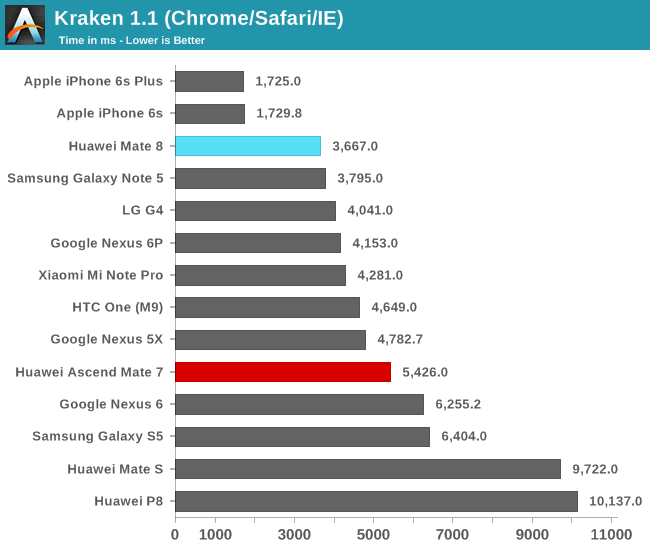
In Kraken the Mate 8 gets the best performance among Android devices with a score of 3667ms. Even though this is a good number, the advantage to the Note 5’s Exynos 7420 is rather small and we still see a large delta to Apple’s latest iPhones. Apple still sees a massive platform advantage due to a much better optimized JavaScript engine in the form of Nitro, as Chrome’s V8 has fallen behind in performance over the last few years, a difference further amplified by the superior single-thread performance of Apples’ CPUs.
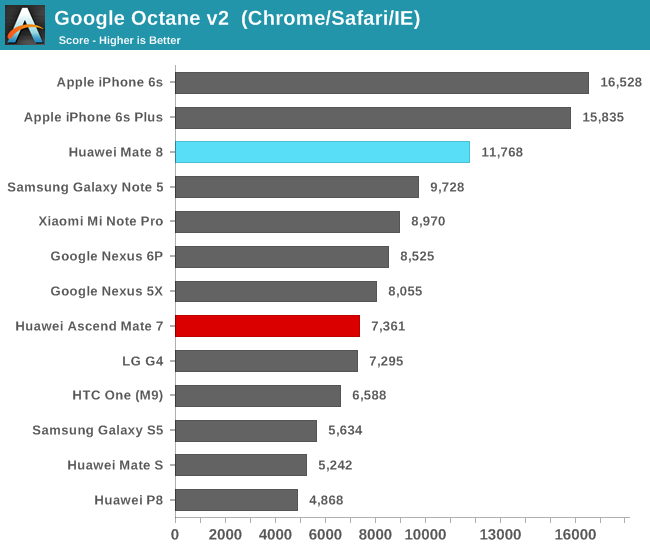
On Octane the Mate 8 is able to better distance itself in Chrome as it shows a more significant performance advantage to Exynos 7420 and Snapdragon 810-based devices, enabling it to lead Android devices.
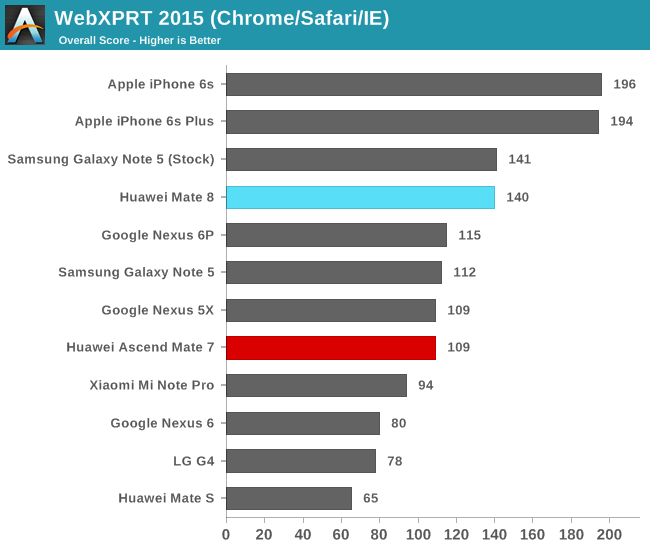
WebXPRT shows a similar large advantage as the Mate 8 is leading Android devices in Chrome. Here again we see the difference an optimized browser can make as Samsung’s SBrowser still is able to slightly lead the Mate 8 even though it has a weaker CPU. It would really be interesting to one day see a full apples-to-apples browser comparison between all hardware platforms out there but unfortunately that’s seems to still be a hard-to-fulfill wish.
We continue on with BaseMark’s BaseMark OS II 2.0 – a system benchmark that tests out different aspects of a device’s performance, starting with a more synthetic system benchmark.
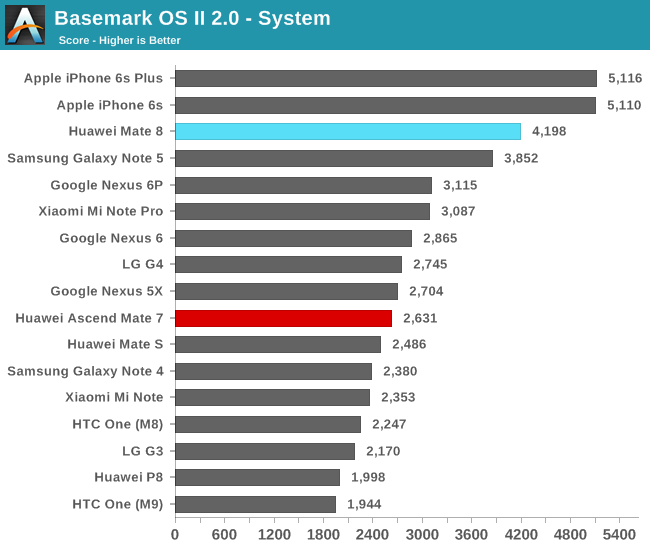
The Mate 8 continues to post impressive results as the fastest Android device to date. The delta between the Kirin 950 and the Exynos 7420 seems rather small here so it might be that we’re seeing the effects of a lot of various properties between the two platforms.
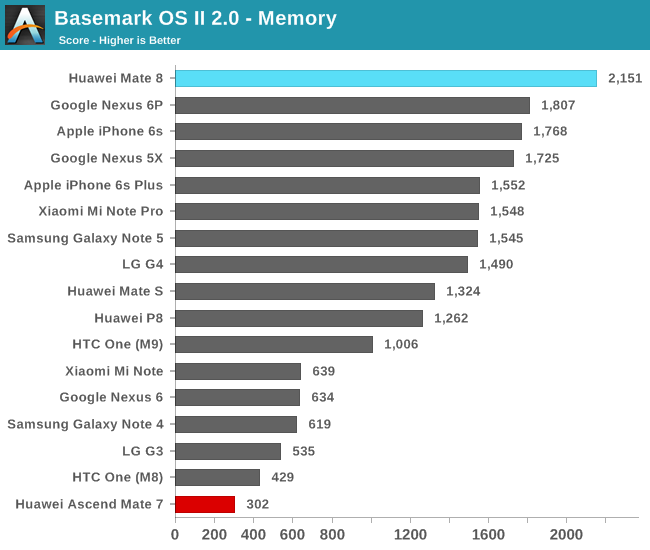
On the memory sub-test the Mate 8 is able to post a very large boost compared to any other device. It’s interesting to see that the devices leading the benchmark are all running Android 6.0 so we might be seeing an OS-side improvement in filesystem API performance. The difference between the Mate 8 and Mate 7 is simply enormous as the Mate 7 had one of the worst-performing NANDs in recent memory, to see Huawei able to go from the worst to the best performer in this test is very encouraging.
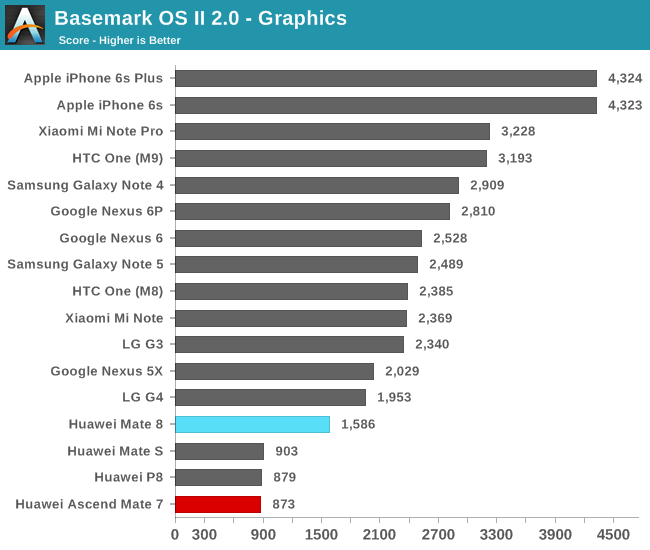
The graphics sub-test of BaseMark OS II has historically been unkind to Mali-based GPUs and the Mate 8 is no exception as we see the Mate 8 perform quite badly compared to other current-generation devices. Nevertheless, the new GPU is able to show a large improvement over the past-generation Kirin devices.

In BaseMark’s web test we see the Mate 8 again perform very well. The Huawei flagship is actually close to the performance of Apple’s new iPhones in this test.
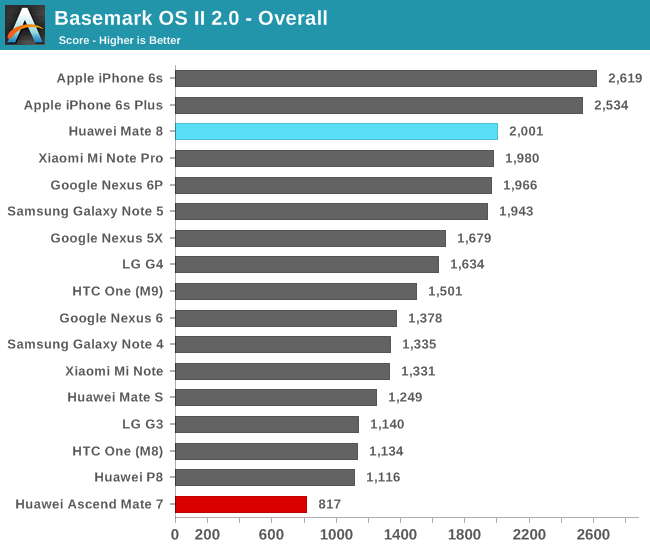
Overall the Mate 8 is able to post the best Android BaseMark score – it’s especially the improvement over last year’s Mate 7 which is drastic.
We continue on with Futuremark’s PCMark – another system benchmark that is able to test everyday scenarios and overall device performance by using stock OS APIs.
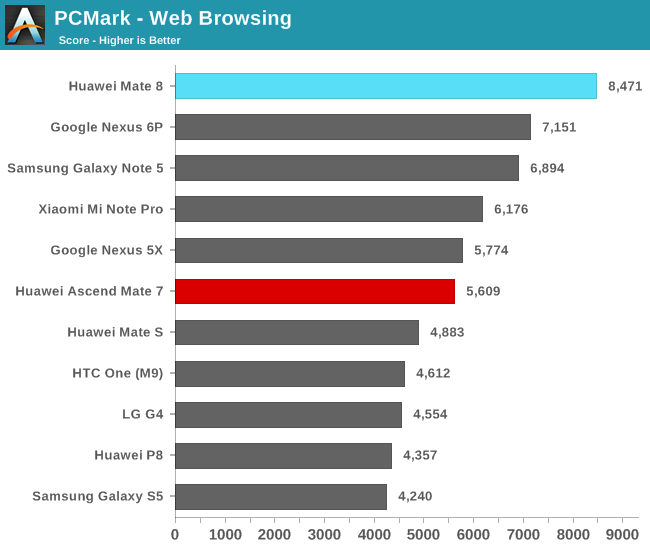
In the web-browsing test the Mate 8 is able to post a significant lead over other devices, scoring almost 8500 points. The firmware upgrade of the Mate 7 also allowed it to catch up to current-generation devices and is now able to better distance itself from Krait Snapdragon devices as software and compilers matured were better able to take advantage of ARM’s A15/57/72 big core architectures and thus age better.
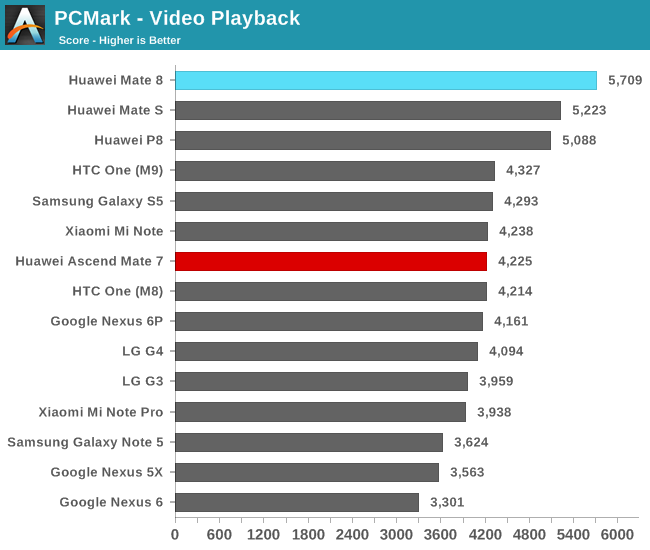
The Mate 8 continues to sport very good video performance. Kirin SoCs use encoder and decoder IPs supplied by Imagination Technologies, Huawei’s devices were seemingly the only ones not affected by a performance degradation in this benchmark that we first saw introduced in Android 5.0.
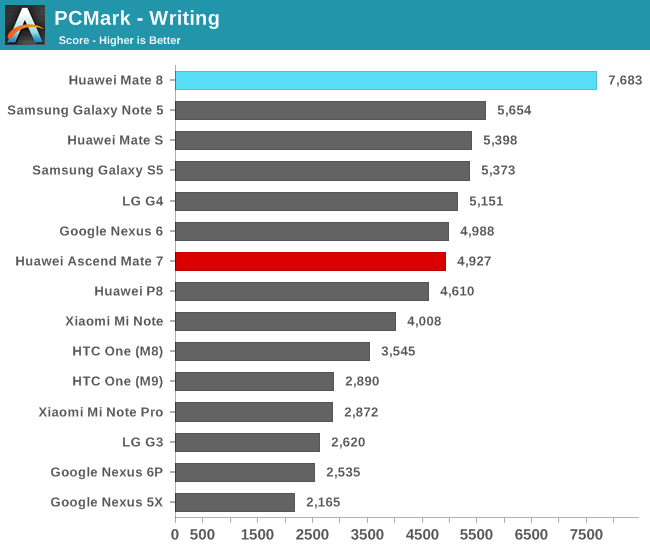
The writing sub-test is where the Mate 8 is able to showcase the single large performance advantage over the competition. The test consists of small latency-dependent performance spikes that test out both raw performance of Android’s Java runtime as well as the SoC’s DVFS and scheduler policies. The Mate 8 being able to score so high seems to be due to Huawei’s optimisations of Android as well as higher average operating performance points enabled by the Kirin 950. Oddly enough this also confirms that the large performance degradation that we saw happening on the Nexus 5X/6P were not caused by Android 6.0 itself but rather by some configuration that Google chose to do on the new phones.
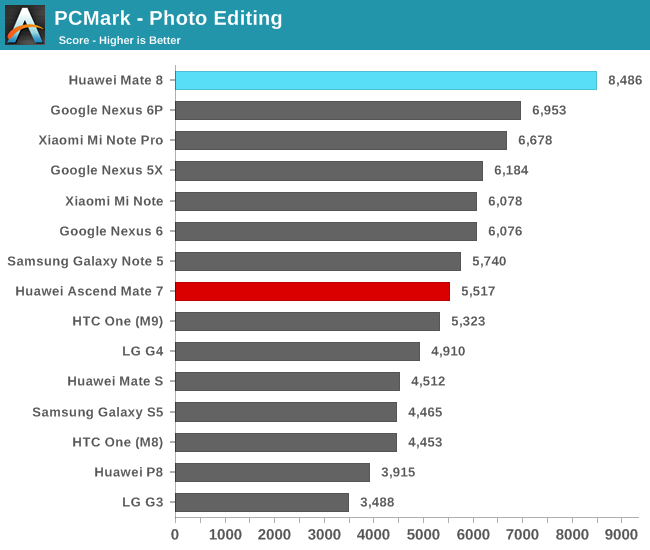
The photo editing test is mainly a GPU-based benchmark runs compute workloads through Android’s stock media effect libraries which rely on RenderScript. The Mate 8 able to score this well even though it doesn’t have the most performant GPU configuration means that either HiSilicon or ARM have greatly improved compute performance for Mali GPUs. The Mate 8 comes with ARM’s r8p0 version of the Mali drivers which is the latest available release. It would be interesting if with future software updates we’ll be able to see similar improvements from other vendors such as on Samsung’s Exynos devices.
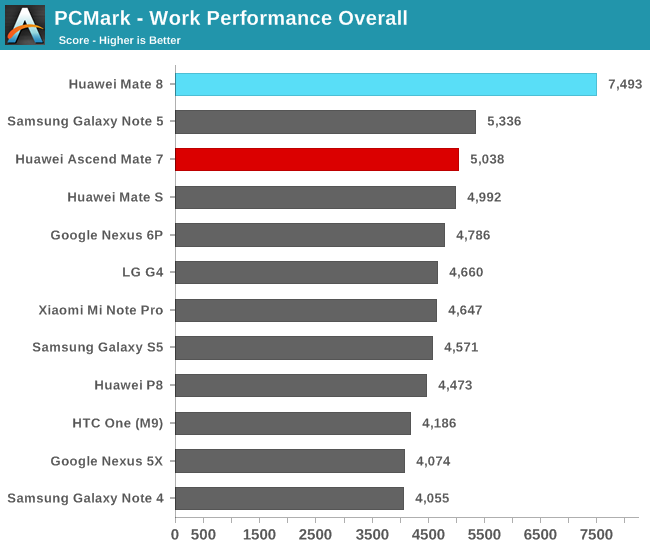
Overall the Mate 8 is able to post an absolutely astounding work performance score in PCMark. The reported score also correctly represents my experience with the device as it is by far the fastest Android phone I’ve ever used. This represents an impressive showing from Huawei that can’t be understated – I was expecting the Kirin 950 to perform well, but we saw a lot of surprises on the software side that puts the Mate 8's system performance as the undoubted leader among the competition.










116 Comments
View All Comments
s.yu - Saturday, January 16, 2016 - link
Which will soon become among the slowest of all flagship CPUs. Please, it's one generation above Exynos 7420 (courtesy of ARM) and still doesn't beat it in all aspects.MrSpadge - Tuesday, January 5, 2016 - link
I don't think it makes any sense yet to name "phones" and "high end games" in the same sentence. (still doing it right now)beachletter - Tuesday, January 12, 2016 - link
The mate 8 achieved similar if not better sustained framerates than the Exynos 7420 in demanding games like nba 2k15/2k16. And that is when the 7420 is also running on 1080p, not 2k (Meizu Pro 5).I'd say GPU on the 950 is totally comparable to Exynos 74xx in actual gameplay because it has so little thermal throttling. In fact, it is probably superior to some phones using snapdragon 810, especially after a few minutes of playtime and on 2k screens. I know because I have a Oneplus 2 which plays like shit after 10-15 minutes game time.
This GPU won't compete with 2016 flagship SoCs, but it can easily match the high end chips currently available in actual usage. The graphics benchmark really don't tell you the whole story.
Lolimaster - Tuesday, January 5, 2016 - link
It seems only Apple, Samsung and maybe Xiaomi cares about display accuracy which is better than focusing on gizmos.5th element - Tuesday, January 5, 2016 - link
Google's devices arent half bad, but I agree with you display accuracy should be of primary concern and I, for the life of me, have no idea why it isn't an this extends right across the board to LCD TVs and monitors.ChronoReverse - Tuesday, January 5, 2016 - link
The reason is because more people prefer the overly saturated colours. The most common comment I get when people look at my previous phones where the colours were set to as accurate as possible for that model is "why does it look washed out?".This is why a screen capable of colour accuracy like the Nexus 6P ends up with a saturated default setting.
s.yu - Saturday, January 16, 2016 - link
That's why Samsung's approach with multiple screen modes makes so much sense. Most will leave it on Adaptive, those who care will change it to Basic or AMOLED Photo. Those watching really badly compressed videos could use AMOLED Cinema.s.yu - Saturday, January 16, 2016 - link
One up that!NZtechfreak - Tuesday, January 5, 2016 - link
I've had one of these for nearly three weeks, a 4gb/64gb one (coming from Note 4 and Nexus 6P previously). This review aligns with my experience. Battery life is easily the best I've had, in the same use it is basically doubling what I had with the Note 4 and 6P. Battery life is fairly high on my priority list and this device is a breath of fresh air in this regard. I had noticed the camera issues, but hadn't picked the reason until Andreilux informed me a few days ago. I'm on a newer B129SP02 firmware, which somewhat ameliorates the issue but not as successfully as it needs to. I think this should be able to be resolved in firmware though, so hopefully will see more of the sensors potential in upcoming updates (I've had three firmware updates so far, so certainly they are moving at a reasonable pace to address issues thusfar). Can update as more firmwares come in if people are interested. Regards the screen my subjective experience matches the review. Coming from the Note 4 in basic screen mode and the 6P in sRGB mode, the garish colours are a bit of an eyesore. Not sure if you mentioned it, but the screen is fairly reflective too, so despite a reasonable brightness sunlight viewing is mildly irritating at times. Blacks for a non-AMOLED screen are sufficient for me, white on warmest colour temp also good enough for me. Overall though the panels performance is acceptable for me. The last firmware update changelog mentioned changes to the colour temp adjustment, but I'm not perceiving a difference. I hope they can refine colour temp adjustment further with firmware updates. Again, not sure if I missed it, but the speaker performance here is really enjoyable - best bass I have heard from a smartphone till now. Speaker performace gets noticeably stressed as you approach 70%+ of the volume range, but volume is plentiful enough beneath that to not give me cause for concern. Pleased with your GPU write-up, a balanced viewpoint (it matches my own, so I suppose I would say that). While GPU performance is not wonderful in raw terms, it exceeds most devices this year for native resolution workloads on account of the 1080p screen. Throttling behaviour is particularly pleasing, since I do mostly emulator gaming on my phone and it's really nice playing the Gamecube's Fire Emblem Path of Radiance at fullspeed here (Dolphin overclock setting at 0.2). Overall I'm well pleased, the camera issue needs resolution, but I use my GH3 for when I really want to take nice shots, so for me it isn't the showstopper that it will be for some on current software.name99 - Tuesday, January 5, 2016 - link
"One characteristic that might be defining for the Kirin 950 is that it still uses a CCI-400 fabric"Might I suggest as a future article one that clarifies what the relationship is between all these ARM terms. We have AMBA, CHI, ACE, CCI and probably a few more I've forgotten. They all seem to have something to do with coherency between different "ARM ecosystem" cells, but what exactly, and how are they all related?